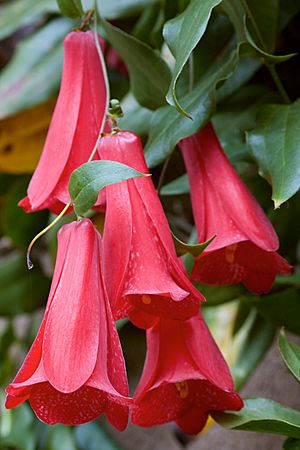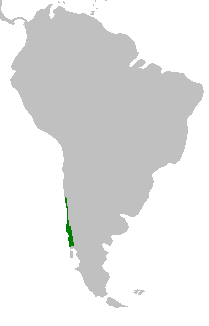Chilean bellflower facts for kids
Quick facts for kids Chilean bellflower |
|
|---|---|
 |
|
| Scientific classification | |
| Genus: |
Lapageria
|
| Species: |
rosea
|
 |
|
| Distribution area of Lapageria rosea | |
| Synonyms | |
|
|
Lapageria is a type of flowering plant that has only one known species, called Lapageria rosea. It's often known as the Chilean bellflower or copihue (pronounced co-pee-wueh). The name copihue comes from the Mapudungun language, spoken by the Mapuche people. The copihue is the national flower of Chile. It grows in the forests of southern Chile, which are part of the Valdivian temperate rain forests.
Contents
What is the Chilean Bellflower?
The Chilean bellflower (Lapageria rosea) is an evergreen climbing plant. This means it stays green all year round. It can grow very tall, reaching over 10 meters (about 33 feet) high. It climbs among shrubs and trees.
Its leaves are arranged one after another along the stem. They are leathery and shaped like a spear. Each leaf has three to seven clear parallel lines, like veins. The plant's vines twist around things. In the Southern Hemisphere, they twist counterclockwise. In the Northern Hemisphere, they twist clockwise. This is probably because of how the sun appears to move.
Flowers and Fruit
The flowers of the Chilean bellflower are beautiful. They have six thick, waxy petals, called tepals. They are usually red with white spots. You can most often see these flowers in late summer and fall. However, they can bloom at other times too.
After the flowers, the plant produces a long fruit. This fruit is a berry with a tough skin. Inside, there are many small seeds, about the size of a tomato seed. These seeds are covered in a fleshy, edible part called an aril. In nature, hummingbirds help pollinate the plant.
How it Gets Pollinated
Pollen from the flowers is spread by birds, especially hummingbirds. Insects and other animals also help. The shape of the flower is perfect for hummingbird pollination. Some insects that pollinate it include a native bee called Bombus dahlbomii. There are also two types of invasive bees, Bombus terrestris and Bombus ruderatus, that pollinate it. These invasive bees are not originally from southern South America.
History of the Chilean Bellflower
In the past, people used to sell the fruit of the Chilean bellflower in markets. But over time, the plant became rare. This happened because too many were collected, and forests where they grew were cut down.
The roots of the plant were also collected a long time ago. They were used as a replacement for sarsaparilla, which is a plant used in drinks and medicines. Because the plant became rare, the Chilean government gave it legal protection in 1977. This means it is now protected by law.
Where Does the Name Come From?
The name Lapageria honors Marie Joséphine Rose Tascher de la Pagerie. She was also known as Napoleon's Empress Josephine. She loved collecting plants for her garden at Château de Malmaison. The word rosea means 'flushed rose' or 'flushed pink'. This describes the color of the flowers.
The Mapudungun name for the fruit is kopiw. This word comes from kopün, which means "to be upside down." The Spanish word copihue comes from kopiw. The Mapuche people call the whole plant kolkopiw. The flower itself is called kodkülla in their language.
Plant Family and Relatives
Lapageria rosea is related to another plant called Philesia magellanica. This plant also comes from the Valdivian forests. It has similar flowers but grows as a shrub, not a climber. There is also a special hybrid plant called ×Philageria veitchii. This plant is a mix between L. rosea and P. magellanica. It looks more like the Chilean bellflower.
Growing Chilean Bellflowers
The Chilean bellflower was brought to Britain by a plant collector named William Lobb. He found it during his trip to the Valdivian temperate rain forests between 1845 and 1848. By 1847, it was growing at Kew Gardens.
If you want to grow this plant, it needs a shady, protected spot. The soil should be acidic or neutral. It can handle cold temperatures down to about -5 degrees Celsius (23 degrees Fahrenheit). So, in places like the UK, it can grow outdoors in mild or coastal areas. The plant has even won the Royal Horticultural Society's Award of Garden Merit. This award means it's an excellent garden plant.
Different Types of Chilean Bellflowers
There are many different types of Chilean bellflowers grown in gardens. These are called cultivars. Most of them were developed at a nursery in Chile. Their flower colors can be very different. They range from deep red to pink, and even pure white (like the 'Albiflora' type). Some even have variegated flowers, meaning they have different colors or patterns.
In the United States, the UC Botanical Garden at the University of California, Berkeley, has one of the largest collections of Lapageria. They have about 24 different types, both named and unnamed. This collection was started by T Harper Goodspeed, a botany professor. The university worked with El Vergel Farm in Chile. This farm had the largest collection of different Lapageria types in the world.
How to Grow New Plants
To get fruit from cultivated plants, you usually need to pollinate them by hand. This is especially true if there are no native hummingbirds around. You can grow new Chilean bellflowers from cuttings, by layering, or from fresh seeds. Some types of plants can pollinate themselves, but you get better results if you use different parent plants.
Seeds sprout best when they are fresh and moist. Dried seeds are harder to grow and don't sprout as well. If you grow new plants from cuttings, they usually flower faster. Plants grown from seeds can take anywhere from three to ten years to flower.
Related pages
- Nolana paradoxa, another plant sometimes called the Chilean bellflower. It's a different species of flowering plant native to central and southern Chile.
Gallery
-
Buds in the Temperate House at the Royal Botanic Gardens, Kew
See also
 In Spanish: Copihue para niños
In Spanish: Copihue para niños





